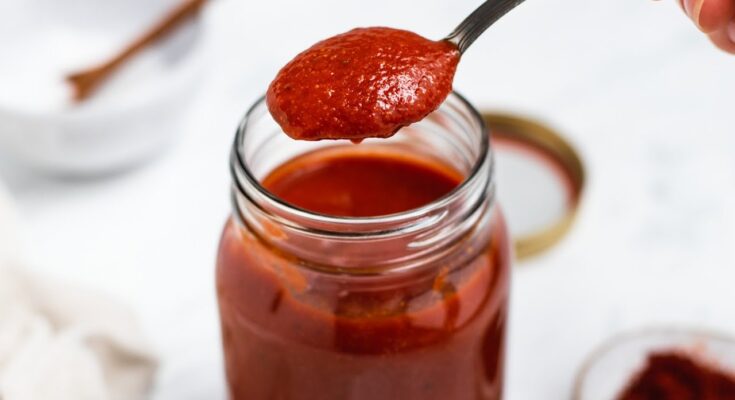Taco Sauce Recipe: Taco sauce is that tangy, zesty, slightly spicy companion that makes your tacos sing with flavor. It’s not salsa, nor is it just hot sauce. Taco sauce hits a perfect balance between tomato richness, vinegar tang, and a savory blend of spices that deliver boldness without overpowering your taste buds. Unlike the chunky texture of salsa, taco sauce is smooth—making it ideal to drizzle, dip, or even marinate.
You’ve likely had taco sauce from popular brands like Taco Bell or Ortega, but nothing compares to the homemade version. When made from scratch, you can tailor the flavor to your liking, from the level of heat to the depth of smokiness. It turns a regular taco into something spectacular and adds a gourmet touch to everything from burritos to scrambled eggs.
Why Make Taco Sauce at Home?
Let’s be real—store-bought sauces often come with preservatives, excess sodium, and mystery ingredients you can’t pronounce. Making taco sauce at home gives you full control over what goes in and how it tastes. Whether you want it extra garlicky, sweeter, or fiery hot, you can tweak the recipe until it hits just right.
It’s also budget-friendly and surprisingly simple. You probably already have most of the ingredients sitting in your pantry. Plus, homemade sauce can last up to two weeks in the fridge, so you’ll always have a flavorful backup when you need a quick meal upgrade.
Key Ingredients for Homemade Taco Sauce
Must-Have Ingredients
Here’s what you’ll need to make a classic taco sauce that’s both delicious and versatile:
- Tomato Sauce (1 cup) – This is the base of your sauce. It provides the body and deep umami flavor.
- Water (1/4 cup) – Helps in achieving a pourable consistency.
- White Vinegar (2 tablespoons) – Adds the signature tang.
- Chili Powder (1 tablespoon) – Brings the heat and earthy spice.
- Paprika (1 teaspoon) – Adds mild peppery warmth and color.
- Cumin (1/2 teaspoon) – Offers a nutty, smoky note.
- Garlic Powder (1/2 teaspoon) – For that irresistible savory kick.
- Onion Powder (1/2 teaspoon) – Rounds out the flavor.
- Sugar (1 teaspoon) – Balances acidity with a touch of sweetness.
- Salt (1/2 teaspoon) – Enhances all the flavors.
These ingredients form a balanced, well-rounded sauce that works with just about any Mexican-inspired dish.
Optional Add-Ons for Flavor Boost
If you want to personalize your taco sauce or just spice things up a bit, consider these optional additions:
- Chipotle in Adobo – For a smoky heat.
- Lime Juice – Adds a citrusy zing.
- Cayenne Pepper – If you want it hotter.
- Smoked Paprika – For a deeper, barbecue-like flavor.
- Fresh Cilantro – Adds freshness if blended in.
These extras can help you tailor the sauce to match your meal or mood. The beauty of homemade sauce is that you can experiment endlessly until you find your favorite version.
Tools and Equipment Needed
Kitchen Tools for Sauce Preparation
You don’t need any fancy equipment to whip up taco sauce. Here’s what’s required:
- Small Saucepan – For simmering the ingredients.
- Measuring Spoons and Cups – Precision matters!
- Whisk or Spoon – To stir and blend everything evenly.
- Blender or Immersion Blender (Optional) – For a smoother consistency.
- Airtight Glass Jar or Bottle – For storage and easy pouring.
That’s it! With just a few basic kitchen tools, you’re all set to become a taco sauce pro.
Step-by-Step Taco Sauce Recipe
Step 1: Gather Ingredients
Start by assembling all your ingredients and tools. This step might seem simple, but it’s crucial to have everything ready before the heat hits the stove. Measure your spices ahead of time and have your tomato sauce, water, and vinegar on standby. This will help the cooking process go smoothly and prevent any last-minute scrambling.
Step 2: Blend for a Smooth Texture
In a bowl or directly into your blender, combine tomato sauce, water, vinegar, chili powder, cumin, paprika, garlic powder, onion powder, sugar, and salt. Blend everything together until the mixture is completely smooth. This ensures all spices are evenly distributed and the texture is just right—silky without being too runny.
Step 3: Simmer and Adjust Flavors
Now that you have your blended sauce, it’s time to cook it and let those flavors develop. Pour the blended mixture into a small saucepan and place it over medium heat. Bring it to a gentle simmer—not a rolling boil. Simmering allows the sauce to thicken slightly and the spices to mellow and meld together into a cohesive flavor profile.
Stir frequently to avoid sticking or burning. After about 10–15 minutes, taste the sauce. This is your opportunity to adjust the flavor. Want it spicier? Add a pinch of cayenne or more chili powder. Need more tang? A dash more vinegar will do the trick. Not sweet enough? Sprinkle a little more sugar.
Remember, taco sauce is all about balance—so don’t go overboard with any one ingredient. Simmer for another 5 minutes after making your adjustments, giving the flavors time to harmonize. By now, your kitchen should smell amazing.
Step 4: Cool and Store Properly
Once your sauce has simmered to perfection, remove it from heat and let it cool for 10–15 minutes. Cooling it before storing prevents condensation from forming inside your container, which could water down your sauce or reduce shelf life.
Transfer the cooled sauce into an airtight glass jar or bottle. Glass is ideal because it won’t absorb flavors or odors, and it helps preserve freshness. Label the jar with the date so you can keep track of how long it’s been in the fridge.
Homemade taco sauce can be stored in the refrigerator for up to two weeks. If you made a big batch, you can also freeze it in small portions using an ice cube tray or freezer-safe containers. Just thaw what you need, when you need it.
Tips and Tricks for the Perfect Taco Sauce
Flavor Adjustments
Here’s where the fun comes in. While the core recipe is delicious as-is, there are countless ways to tweak it to match your personal taste or dietary needs. Want it smokier? Swap out the regular paprika for smoked paprika. Need it keto-friendly? Replace the sugar with a keto-approved sweetener like erythritol or monk fruit.
You can also experiment with adding:
- Fresh herbs like cilantro or oregano
- A splash of soy sauce for umami depth
- Lime or lemon juice for brightness
The key is to make small changes and taste as you go. Think of this sauce as a canvas—and you’re the artist.
Storage Hacks and Shelf Life
If you’re anything like me, once you start making taco sauce at home, you’ll always want a stash ready. To make sure it lasts:
- Always use a clean spoon when dipping into the jar.
- Store it in the coldest part of your fridge (usually the back).
- Freeze it in small portions so you only thaw what you’ll use.
Frozen taco sauce will last up to 3 months. Just thaw it overnight in the fridge or use a water bath if you’re in a rush.
FAQs about Taco Sauce Recipe
How long does homemade taco sauce last?
Homemade taco sauce lasts up to two weeks in the refrigerator when stored in an airtight container. Make sure to use clean utensils when scooping it out to avoid contamination. If frozen in small batches, it can stay good for up to three months.
Can I freeze taco sauce?
Absolutely! Taco sauce freezes well. Just pour it into ice cube trays or freezer-safe containers. Once frozen, transfer the cubes into a zip-top bag. This way, you can thaw just what you need. Perfect for quick weeknight meals.
Is taco sauce the same as salsa?
Not exactly. While both are tomato-based and used in Mexican cuisine, taco sauce is smooth, tangy, and cooked, with a thinner consistency. Salsa, on the other hand, is typically chunky, can be raw, and often contains fresh ingredients like onions, cilantro, and peppers.
How spicy can I make it?
You can make taco sauce as mild or as fiery as you like! To increase the heat, add ingredients like cayenne pepper, chipotle in adobo, or fresh chopped jalapeños. If you’re spice-sensitive, just stick with chili powder and adjust gradually.
What dishes can I use taco sauce with?
Taco sauce is incredibly versatile. Besides tacos, try it on:
- Burritos and enchiladas
- Quesadillas and nachos
- Scrambled eggs and breakfast burritos
- Grilled chicken or steak
- Rice bowls and roasted veggies
It’s more than just a topping—it’s a flavor booster!
Conclusion
So there you have it—a full, flavorful guide to making your own taco sauce right in your kitchen. With just a handful of pantry staples and a few simple steps, you can whip up a sauce that blows store-bought versions out of the water. Homemade taco sauce isn’t just about better taste—it’s about control, customization, and keeping things fresh and clean.
Whether you’re meal prepping for the week, hosting a taco night, or just craving a savory drizzle for your eggs or nachos, this sauce has your back. And the best part? It’s incredibly forgiving. Once you get the basics down, you can experiment endlessly—dialing up the spice, adding smoky flavors, or going citrusy and bright.
Make it your go-to secret weapon in the kitchen. It’s amazing how one simple condiment can elevate everything from tacos and burritos to burgers and grilled veggies. So go ahead—put your own spin on it, jar it up, and enjoy the zesty goodness every time a meal needs that extra punch.



